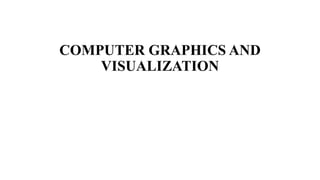
graphics.pptx
- 3. What is point? • A geometrical point is a location in space. • It has no other characteristics. • It has no length, width, or thickness. • It is pure location. • In geometry, the word point is not defined. • It is one of the undefined primitives that are used to define other objects.
- 4. • The picture shows two cupolas on top of a building. • The picture is 2D, but think about the actual 3D building. • Focus on the spike (finial) at the top of the closest cupola. • What is the location of the very top of the spike? On the scale of the building, the sharp end of the spike defines an exact location. • We can conceptualize that location as a point.
- 5. • A point is an idealization. • On the scale of a building, the end of a spike is small enough to be considered an exact location, a point. • But on the scale of your desk, its end is too blunt to exactly define one location. • At the scale of a desk, the spike would have to taper to a pin point. • Then, perhaps, you could consider its end to define a point. • But if you put that pin point under a microscope, then for that scale it is again too blunt.
- 6. • It would have to taper further, perhaps to the thickness of a bacterium, before the end could define a point. • But now, on the scale of bacteria, the end of the spike is again too thick to exactly define a location. • So, points in 3D space are an idealization. • For a computer model of a building, the sharp end of a spike is exact enough to be a point. • The edges, planes, and other shapes that make up the building do not need to be specified to any greater accuracy.
- 7. LINES • Now think about the line segment between the two points. • A line segment is the straight path between two points. • It has no thickness. • There is only one line segment between the two points. • Again, if you did not already have the concept of "line" the above definition would not be enough to learn it. • In 3D graphics you mostly deal with line segments.
- 8. • In geometry, lines continue without end. • A line segment is the part of a line between two points. • In geometry books the word line is usually not defined. • It (like point) is an undefined concept used to define other objects. • Often people say "line" when properly they should say "line segment."
- 9. • At the scale of the building, a thin wire stretched between the two spikes is a close approximation to a line segment. • Again, this is a matter of scale. • The wire is likely to be thicker than a line drawn by a pencil. • But on an architectural level, taught wires can be considered line segments. • You could build a geometrical model of the building using line segments to represent edges.
- 10. REPRESENTATION • You can think about the points, lines, and plane figures that compose the 3D scene without using a coordinate system. • In fact, that is what we have been doing. • But in computer graphics we need to represent these objects, somehow, and to manipulate them. • Pick a convenient point in the 3D scene and call it the origin.
- 11. • Now define three lines called X, Y, and Z that go through the origin. • Usually the three lines are perpendicular to each other. • Each line is called an axis. • Pick a positive direction for each line. • Now each point of the X axis is a unique distance (positive, negative, or zero) from the origin. • For example, the corner of the building that lies on the X axis is at a distance of 8.0 feet (or so) from the origin.
- 17. Queries?
- 18. THANK YOU